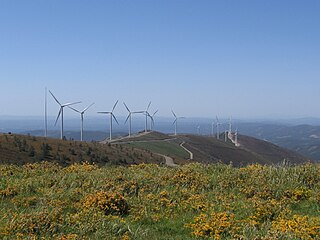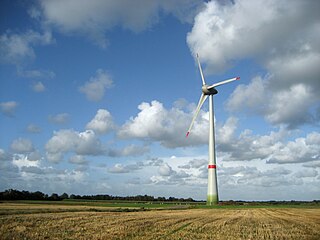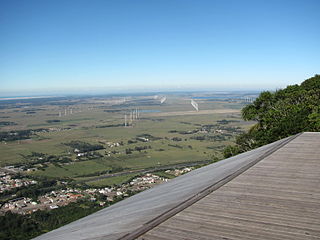
A wind farm or wind park, also called a wind power station or wind power plant, is a group of wind turbines in the same location used to produce electricity. Wind farms vary in size from a small number of turbines to several hundred wind turbines covering an extensive area. Wind farms can be either onshore or offshore.

Iberdrola is a Spanish multinational electric utility company based in Bilbao, Spain. Iberdrola has a workforce of around 40,000 employees serving around 30 million customers. Subsidiaries include Scottish Power and a significant part of Avangrid, amongst others. As of 2023, the largest shareholder of the company is the Qatar Investment Authority, with BlackRock and Norges Bank also holding significant interests.

Spain is one of the countries with the largest wind power capacity installed, with over 27 GW in 2020. In 2013, it had become the first country in the world to have wind power as its main source of energy.

Wind power in Germany is a growing industry. The installed capacity was 55.6 gigawatts (GW) at the end of 2017, with 5.2 GW from offshore installations. In 2020, 23.3% of the country's total electricity was generated through wind power, up from 6.2% in 2010 and 1.6% in 2000.

Wind power' is a major source of energy in Portugal. At the end of 2020, wind power capacity in Continental Portugal was 5,456 MW. In 2020, wind power represented 23.7% of total electricity generation.
The 112 megawatt (MW) Arada–Montemuro Wind Farm is an onshore Wind Farm in the Viseu district of Portugal. It uses Enercon E-82 wind turbines.

Volkswind GmbH is one of the largest operators of wind farms in Germany. The company was founded in 1993 by Martin Daubner and Matthias Stommel, former Enercon employees. The company's headquarters is in Ganderkesee, Germany, and has worldwide subsidiaries in France, England, Poland, Bulgaria and the US.

Community wind projects are locally owned by farmers, investors, businesses, schools, utilities, or other public or private entities who utilize wind energy to support and reduce energy costs to the local community. The key feature is that local community members have a significant, direct financial stake in the project beyond land lease payments and tax revenue. Projects may be used for on-site power or to generate wholesale power for sale, usually on a commercial-scale greater than 100 kW.
The Markbygden Wind Farm is a series of interconnected wind farms in the Markbygden area west of Piteå, Norrbotten County in northern Sweden. The project is expected to be completed by 2025 and could have a total capacity of up to 4,000 megawatts (MW), comprising up to 1,101 wind turbines. The project was initially co-developed by Svevind AB and wind turbine manufacturer Enercon. Combined the Markbygden Wind Farm is already the biggest wind farm in Europe, on track to be one of the biggest onshore windfarms in the world.

Wind power in Italy, at the end of 2015, consisted of more than 1,847 wind turbines with a total installed capacity of 8,958 megawatts. Wind power contributed 5.4% of Italy electricity generation in 2015 (14,589 GWh). Italy is ranked as the world's tenth producer of wind power as of the end of 2016. Prospects for Italian wind energy beyond 2020 were positive, with several projects planned to go live before 2030.

The Enercon E-126 is an onshore wind turbine model manufactured by the German company Enercon. With a hub height of 135 m (443 ft), rotor diameter of 126 m (413 ft) and a total height of 198 m (650 ft), the turbine can generate up to 7.58 megawatts of power, making it the largest wind turbine in the world for several years, until it was overtaken in 2014 by the Danish company Vestas with their V164-8.0 turbine. Their model number is a reference to their rotor diameter.
The Locust Ridge Wind Farm is a large wind farm located near Mahanoy City in Schuylkill County, Pennsylvania, United States. The first phase, Locust Ridge I, has 13 Gamesa 2MW Wind Turbines that began commercial operation in 2006. The wind farm has a combined total nameplate capacity of 26 MW, producing about 68,328 megawatt-hours of electricity annually, which is enough to power 24,000 homes.

Wind power in Belgium depends partially on regional governments and partially on the Belgian federal government. Wind energy producers in both the Flemish and Walloon regions get green certificates but not with the same conditions.

As of November 2023, wind power in the Netherlands has an installed capacity of 11,602 MW, 40.9% of which is based offshore. In 2022, the wind turbines provided the country with 18.37% of its electricity demand during the year. Windmills have historically played a major part in the Netherlands by providing an alternative to water driven mills.

Blyth Harbour Wind Farm is a coastal wind farm located in East Bedlington along the East Pier of the Port of Blyth. Commissioned in January 1993 it consists of nine 0.3 MW WindMaster turbines giving a total capacity of 2.7 MW. It was developed by AMEC Wind and is owned by Hainsford Developments Limited.

The Osório wind farm is a wind farm in Southern Brazil, on land near the coast, located near the coastal city of Osório, Rio Grande do Sul. It has maximum power generation capacity of 318 megawatts, a large capacity which ranks among the largest in the southern hemisphere.
Innergex Renewable Energy is a developer, owner and operator of run-of-river hydroelectric facilities, wind energy, and solar farms in North America, France and South America. While many of the firm's operational assets are located in its home province of Québec, it has expanded into Ontario, British Columbia, and Idaho, as well as Chile and France

The great majority of wind turbines around the world belong to individuals or corporations who use them to generate electric power or to perform mechanical work. As such, wind turbines are primarily designed to be working devices. However, the large size and height above surroundings of modern industrial wind turbines, combined with their moving rotors, often makes them among the most conspicuous objects in their areas. A few localities have exploited the attention-getting nature of wind turbines by placing them on public display, either with visitor centers on their bases, or with viewing areas farther away. The wind turbines themselves are generally of conventional horizontal-axis, three-bladed design, and generate power to feed electrical grids, but they also serve the unconventional roles of technology demonstration, public relations, and education.

Talinay Wind Farm, also known by its official name of Parque Eolico Talinay, is a wind farm in northern Chile, located in the region of Coquimbo near the city of Ovalle. It has an installed capacity of 90 MW and is capable of generating about 200 GWh annually, which is set to be expanded to 500 MW in the future, with a second wind park Parque Eolico Talinay II adding a further 500 MW.

Avedøre Holme Offshore Wind Farm is a nearshore wind farm right off the coast of Avedøre, Copenhagen. It was commissioned in 2009 with three 3.6 MW Siemens turbines as a demonstrator project for future offshore wind turbines. Ørsted owns two turbines, and a private collective owns the third. Ørsted and partners build a 2MW hydrogen electrolysis station at Avedøre Power Station supplied by Ørsted's two turbines.
















